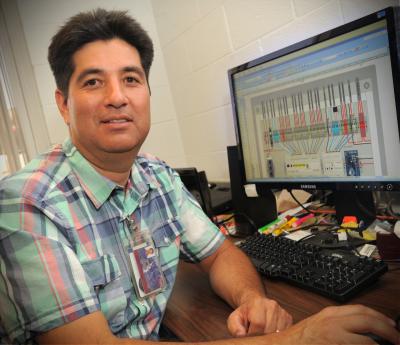Saving on the power bill isn't just for homeowners

The bill is big, and with air conditioners and swamp coolers running this time of year, the bill is even higher. Lorraine Silva, a senior accountant with Facilities and Services Operations, says that NMSU's peak months of demand are July, August and September. The June electric bill for the NMSU Las Cruces campus was $325,237. And that's just the electricity we purchase from El Paso Electric. Ouch.
Now that you've been shocked with the cost to power the campus, here is some good news - NMSU has several complex systems in place to not only monitor our energy consumption, but to help reduce it. And, NMSU does create some of its own power, too, and takes advantage of off-peak billing rates for power-intensive operations like chilling the water in the chillers, which is then used to cool the campus.
Pat Chavez runs NMSU's energy management program and is able to handle this highly involved, technical job from a computer in his office, using a system called Tridium Niagara AX, or Niagara, for short.
"My role here at New Mexico State is to manage, monitor and assess the energy consumptions and design and maintain automation control systems to help optimize and save energy," Chavez said. "Primarily, it's much like the way the automotive industry has come along from where you start with a basic carburetor type of setup, where you're trying to advance it to the great computer-controlled technology. That's why we're getting great mileage in cars today. We're trying to do that on the building side of the system. We add sophisticated electronics and communications, so all of that data can migrate to a central system, where we can control it remotely."
The Niagara system shows everything from the system meters on campus and monthly use totals, to which fans are currently operational in certain buildings. This complex and customized system allows Chavez to monitor and analyze energy use on campus - and to be quickly alerted when something is awry.
Niagara is also helpful for maintenance and troubleshooting, giving the technicians who are dispatched on work orders a better idea of what the problem might be before they every arrive at the work site.
"This is a very empowering tool because we technically have the muscle to force shutdown things if we see something on the end-user side that is not-so-desirable from an energy standpoint, and we can manually turn these things off," Chavez said.
A good example of undesirable use is heating or cooling an empty building on weekends or over the holidays, which is simply a waste of energy and money. Another example is when buildings are cooled below the NMSU campus temperature set point standard of 76 degrees when occupied or 85 degrees when unoccupied. While some facilities are granted exceptions because of unique requirements because of the mission of the facility, the rest of campus is asked each year to adhere to the policy.
However, Chavez does not have control over the temperatures in all buildings on campus, most notably, residence halls and housing units, as those are dwellings, not office, classroom or laboratory space, and the residents control their own temperature set points.
There are approximately 60 buildings on campus with some form of digital controls in place, but 28 of those still that have yet to be retrofitted with controls to the individual room level, allowing more detailed management of those systems through Niagara. Part of Chavez's job is to identify buildings for retrofits, then follow through with the projects as funding becomes available for the work.
"It's all about the energy. It's no secret that, even in the household, you start becoming very aware of the utility bills, the increasing cost and the environmental awareness," Chavez said. "It really is a huge driving factor now, the utilities, and needing the technology to really optimize [efficiency] and just not have a lot of waste."


